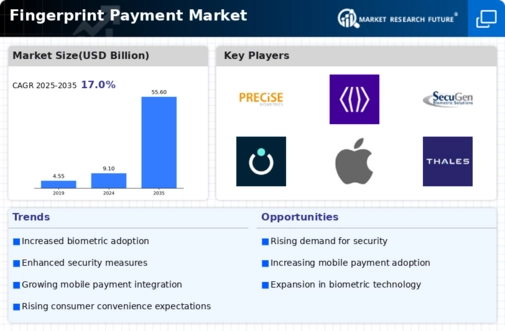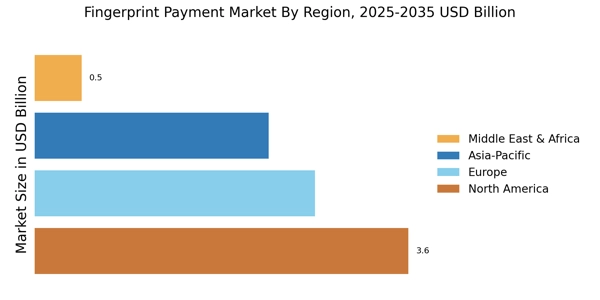Increased Focus on Fraud Prevention
The Fingerprint Payment Market is witnessing an increased focus on fraud prevention measures. As cyber threats and payment fraud continue to evolve, businesses are seeking more secure payment methods to protect their customers. Fingerprint payments offer a robust solution, as they are inherently more secure than traditional methods. Data shows that biometric authentication can reduce fraud rates by up to 90%, making it an attractive option for merchants. This heightened emphasis on security is likely to drive the adoption of fingerprint payment solutions, as companies prioritize safeguarding customer information. Consequently, the Fingerprint Payment Market is expected to grow as organizations invest in advanced security technologies.
Growing E-commerce and Digital Payment Adoption
The Fingerprint Payment Market is benefiting from the rapid growth of e-commerce and digital payment platforms. As consumers increasingly prefer online shopping, the demand for secure and efficient payment methods has intensified. Data indicates that e-commerce sales are expected to reach over 6 trillion dollars by 2024, creating a fertile ground for fingerprint payment solutions. The convenience and security offered by biometric payments are appealing to both consumers and merchants, potentially leading to a significant increase in transaction volumes. This trend suggests that the Fingerprint Payment Market will continue to thrive as more businesses adopt these technologies to enhance customer experience.
Technological Advancements in Biometric Systems
The Fingerprint Payment Market is experiencing a surge in technological advancements, particularly in biometric systems. Innovations in fingerprint recognition technology, such as enhanced algorithms and sensor capabilities, are driving the adoption of fingerprint payment solutions. According to recent data, the accuracy of fingerprint recognition has improved significantly, with false acceptance rates dropping to as low as 0.001%. This increase in reliability is likely to bolster consumer confidence in biometric payments, leading to a projected market growth rate of 20% annually over the next five years. As businesses seek to integrate these advanced systems, the Fingerprint Payment Market is poised for substantial expansion.
Integration with Internet of Things (IoT) Devices
The integration of fingerprint payment solutions with Internet of Things (IoT) devices is emerging as a key driver for the Fingerprint Payment Market. As IoT technology becomes more prevalent, the potential for seamless and secure transactions through connected devices is expanding. For instance, smart home devices and wearables equipped with fingerprint sensors can facilitate payments without the need for traditional payment methods. This trend is supported by data indicating that the number of connected IoT devices is projected to reach 30 billion by 2025. The Fingerprint Payment Market stands to benefit significantly from this integration, as it offers consumers a convenient and secure payment experience.
Consumer Awareness and Acceptance of Biometric Payments
Consumer awareness regarding the benefits of biometric payments is on the rise, positively impacting the Fingerprint Payment Market. Educational campaigns and marketing efforts by payment solution providers are fostering a better understanding of the security and convenience associated with fingerprint payments. Recent surveys indicate that approximately 70% of consumers are willing to use biometric authentication for transactions, reflecting a growing acceptance of these technologies. This shift in consumer behavior is likely to drive demand for fingerprint payment solutions, as businesses strive to meet the expectations of tech-savvy customers. The Fingerprint Payment Market is thus positioned to capitalize on this trend.


















Leave a Comment